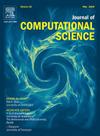PDE-LDDMM meets NODEs: Introducing neural ordinary differential equation solvers in PDE-constrained Large Deformation Diffeomorphic Metric Mapping
IF 3.7
3区 计算机科学
Q2 COMPUTER SCIENCE, INTERDISCIPLINARY APPLICATIONS
引用次数: 0
Abstract
Non-rigid image registration is a crucial task in various medical applications, allowing the alignment of images with complex spatial or temporal variations. This paper introduces NODEO-LDDMM and NODEO-PDE-LDDMM, two innovative deep-learning-based approaches that bridge the gap between Large Deformation Diffeomorphic Metric Mapping (LDDMM) and neural ordinary differential equations (NODEs). LDDMM and PDE-LDDMM offer mathematically well-established formulations for diffeomorphic registration, while NODEs provide the flexibility of deep-learning in the solution of the ODEs involved in both methods. Both NODEO-LDDMM and NODEO-PDE-LDDMM include the strengths of deep-learning into LDDMM, enabling a robust optimization with a good balance between accuracy and transformation smoothness in their solutions. Our proposed methods reached or outperformed their traditional counterparts and the nearly diffeomorphic deep-learning-based approaches selected as benchmarks. This work contributes to advancing non-rigid image registration techniques, with a methodology suited to overcome some of the limitations of deep-learning in medical image registration.
PDE-LDDMM满足节点:引入神经常微分方程求解法求解pde约束大变形微分同构度量映射
非刚性图像配准是各种医学应用中的一项关键任务,允许具有复杂空间或时间变化的图像对齐。本文介绍了node -LDDMM和node - pde -LDDMM这两种创新的基于深度学习的方法,它们弥补了大变形微分同构度量映射(LDDMM)和神经常微分方程(NODEs)之间的差距。LDDMM和PDE-LDDMM为微分同构配准提供了数学上完善的公式,而节点为两种方法中涉及的ode的解决方案提供了深度学习的灵活性。NODEO-LDDMM和NODEO-PDE-LDDMM都将深度学习的优势融入到LDDMM中,在解决方案的准确性和转换平滑性之间取得了良好的平衡,从而实现了鲁棒优化。我们提出的方法达到或超过了传统的同行和作为基准的近微分同构的基于深度学习的方法。这项工作有助于推进非刚性图像配准技术,其方法适合克服医学图像配准中深度学习的一些局限性。
本文章由计算机程序翻译,如有差异,请以英文原文为准。
求助全文
约1分钟内获得全文
求助全文
来源期刊

Journal of Computational Science
COMPUTER SCIENCE, INTERDISCIPLINARY APPLICATIONS-COMPUTER SCIENCE, THEORY & METHODS
CiteScore
5.50
自引率
3.00%
发文量
227
审稿时长
41 days
期刊介绍:
Computational Science is a rapidly growing multi- and interdisciplinary field that uses advanced computing and data analysis to understand and solve complex problems. It has reached a level of predictive capability that now firmly complements the traditional pillars of experimentation and theory.
The recent advances in experimental techniques such as detectors, on-line sensor networks and high-resolution imaging techniques, have opened up new windows into physical and biological processes at many levels of detail. The resulting data explosion allows for detailed data driven modeling and simulation.
This new discipline in science combines computational thinking, modern computational methods, devices and collateral technologies to address problems far beyond the scope of traditional numerical methods.
Computational science typically unifies three distinct elements:
• Modeling, Algorithms and Simulations (e.g. numerical and non-numerical, discrete and continuous);
• Software developed to solve science (e.g., biological, physical, and social), engineering, medicine, and humanities problems;
• Computer and information science that develops and optimizes the advanced system hardware, software, networking, and data management components (e.g. problem solving environments).
 求助内容:
求助内容: 应助结果提醒方式:
应助结果提醒方式:


